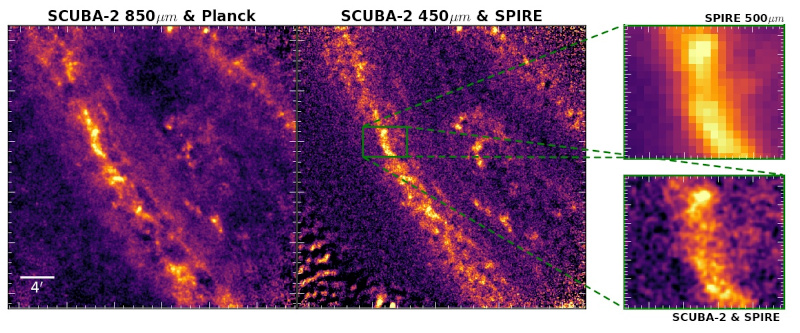
Data Release 1 is Now Avilable!

HASHTAG or the Harp and Scuba-2 High Resolution Terahertz Andromeda Galaxy Survey is a Large Program
on the JCMT to observe the entirety of Andromeda with SCUBA-2 at 450 and 850µm, and we will also
observe selected regions in CO(J=3-2) with HARP. The project will started in summer 2017 and will use approximately 275 hours to complete observations. Our survey will make it possible, for the first time, to investigate dust, the ISM and star formation from the scale of a galaxy down to sub-GMC scales. With a resolution of approximately 25 parsecs, we will be able to study Andromeda with five times better resolution than studies based on spaced-based data. The figure below shows the results of our pilot SCUBA-2 observations, and indicates the image quality that will be obtained with the full survey.

Andromeda is an ideal laboratory for studying star-formation, the ISM and the properties of dust. As it is in the Local Group it has been intensely studied with observatiosn spanning the entire spectrum, and its proximity means in optical it is possible to detect individual stars. Within the Local Group M31 is special because it is the other big spiral, with a mass slightly larger than the Milky Way (Yin et al., 2009). Although similar in many ways to the Milky Way, it is also a useful contrast because it has a much larger bulge and less obvious spiral arms, with most star formation occuring in a ring.
The main science aims of HASHTAG are described in the following three sections.
The dust in M31 is already a challenge for dust models, with radial variation in beta, an inverse relationship between beta and temperature, and a ratio of dust emissivity to dust extinction that is 2.5 times greater than the value predicted by the most widely used models. By combining our high-resolution dust maps with the results from the Panchromatic Hubble Andromeda Treasury (PHAT) and maps of the atomic and molecular gas, we will investigate the properties of the dust, investigating for example whether the variation in dust properties is primarily driven by the temperature, composition or age of the dust.
By comparing the maps of dust, molecular gas and atomic gas, we will measure the mass of CO-dark gas in M31 and determine the variation in the CO X-factor and gas-to-dust ratio across the galaxy. Using the dust map and our measurements of the gas-to-dust ratio, we will produce a high-resolution map of the ISM column density.
We will use this map to produce a catalogue of approximately 2000 clouds with masses >103 solar masses. The cloud catalogue will allow us to move the study of star formation in galaxies from the relationship between star formation and gas on large scales (the Kennicutt-Schmidt relation) onto the more interesting investigation of the physical relationship between the clouds and the stars forming within them. We will use the catalogue, for example, to investigate whether there is a single evolutionary history for a cloud or whether the history of a cloud depends on its location within the galaxy.